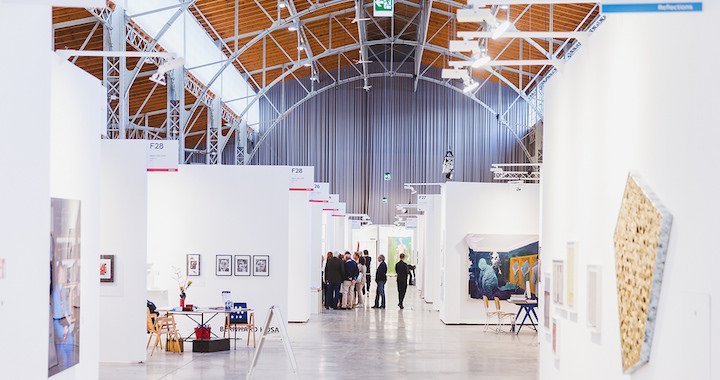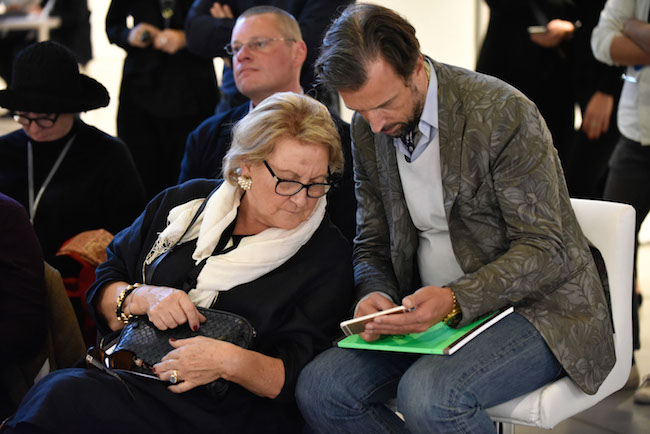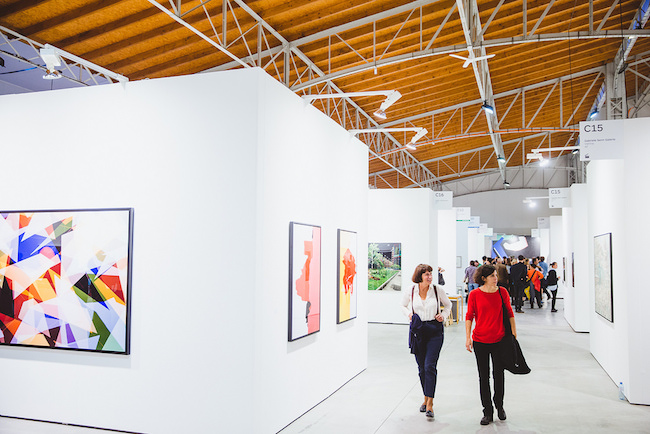
“Maybe the mega-fairs will die, and maybe the smaller ones will survive”
A look back at Vienna’s viennacontemporary art fair
Agnese Čivle,
05/10/2016
Having run for five days, the viennacontemporary art fair’s closing numbers were 28,316 visitors, and several registered sales. It seems that the only art fair focusing on Central and Eastern European art has risen to such a level that it’s worth speculating about a broader future for regional art fairs. Perhaps, along with many other signs of change regarding both the future of museums and the transformation of media geared towards art (two subjects that were covered in a number of discussions surrounding the fair), the art world’s currently most visible feature – the art fair – is also on the cusp of a major overhaul. Is the flourishing of art fairs that lie outside the realm of mega-fairs (e.g., Art Basel, ARCOmadrid, FIAC, etc.) an indication of paradigm change? After all, aren’t these new players in the art market, including viennacontemporary, only positive for the often (and undeservedly) left-by-the-sidelines Eastern European art scene? From now on, this issue will certainly be on the agenda for , but for the moment, let’s take a look at how various prominent art-world figures encountered at viennacontemporary view the situation.
.jpg)
viennacontemporary fair view. Photo: © viennacontemporary
On the cusp of change
Art-world figures at viennacontemporary confirm the ascendancy of regional art fairs
“I think it’s a time for smaller fairs, which can react faster, and which are not so much under the control of certain networks. They have their specific niche. It can be drawings, it can be Eastern European art, whatever. And in my opinion, viennacontemporary is where those who are interested in Eastern European art should go, because this is where one can find out the most about it. And, thanks to God, we have fantastic artists everywhere – in Poland, in Slovenia, in the former Yugoslavia, Romania, etc. I did a stand last year with Ukrainian art; nobody knew them, but it worked very well, and everybody was happy to get introduced to these artists who had been working for many years, but simply hadn't been able to get out of their country. Here, in Vienna, they have a kind of platform. So, that makes the fair interesting, and perhaps, also successful”. It was this commentary by German gallerist Volker Diehl that gave the impetus to also ask other prominent figures at the fair about the future of small and regional art fairs.
Concurring about a likely successful future for art fairs of this kind was curator Julien Robson, who had organized the viennacontemporary’s Collectors Forum. Robson spoke in terms of both fact and metaphor with this comment: “It’s a hangover now because when you go to Art Basel Miami Beach – it really is only a party!” After a period of intoxication, one needs to detox the body by way of going off of the beaten path.

Viennese gallerist Ursula Krinzinger, Austrian collector Michael Klaar (in the background), and Belgian art collector Alain Servais at the launch of issue No. 3 of the “Arterritory Conversations with Collectors” magazine. Photo: © viennacontemporary / Henk Jan Kamerbeek
Ursula Krinzinger, from Galerie Krinzinger, underscores that the art-fair business-sharks have identified that changes are coming, and are already setting their sights: “Why would the Art Basel people try to buy up the regional fairs? They want to have local collectors, they want to have a local atmosphere – a different one from that internationalized one. I think that local fairs will be very important...and it looks like the masters of the economy, the masters of finance, have already understood this.”
Ingesting things of nutritional value is an important part of recovery, which is why Robson points out the quality that smaller art fairs offer: “Maybe we are getting tired of commodity art – of a kind of ‘Koons’ syndrome’. Here at viennacontemporary, you can encounter a really serious work that’s not going to cost a huge amount of money. This fair also brings you into contact with works that come from places that are really productive and interesting, but that just do not have visibility at those mega-fairs. And maybe the mega-fairs will die. And maybe the smaller fairs will survive.”

German gallerist Volker Diehl at the launch of issue No. 3 of the “Arterritory Conversations with Collectors” magazine. Photo: © viennacontemporary / Henk Jan Kamerbeek
Galleries are also slowly beginning to move away from the mega-fairs. German gallerist Volker Diehl did so several years ago, explaining to : “I pretty much stopped doing fairs a few years ago because I didn’t like the way how most of them are organized. Most of the fairs have, like, ten blockbuster galleries, whereas the greater part of the fair is made up of small- and medium-sized galleries; these smaller galleries end up covering the costs of the fair, while the big galleries rake in most of the profits and control the market. I just didn't like this whole political aspect, this movement that’s been going on for the last ten, fifteen years. And which, I think, is not for the sake of art – it’s just for a few people and their own benefit.” It was specifically because of viennacontemporary that Diehl’s gallery returned to the art fair as such – because its divergent concept spoke to him. He also emphasizes the aspect of quality art for a sensible price: “At Frieze or Art Basel, the costs are so high that you can't show this kind of nice-level art that goes for around 5000, 10 000, or 15 000 euros. But it can be very, very good art. And I am more interested in good art than in big prices.”
Art collector Alain Servais, from Belgium, joins in on the opinion that at this fair, one can discover surprising galleries that were previously unknown; an example for him was the Vilnius gallery Vartai, from which he was contemplating acquiring a piece by Vytautas Viržbickas. Servais also sees a bright future for regional art fairs, but only on the condition that they closely adhere to their focus of choice: “In my opinion, viennacontemporary has a good focus and good selection, but I would push it a little bit further. I see that there are some galleries here that come from other parts of the world, but if your thematic concept is Eastern and Central Europe, perhaps it is better to stick to it even closer. (But, of course, I know it is not easy to fill the booths, and it’s a real estate business – it’s about selling square meters.)”.
Swiss gallerist Patrick Urwyler from Chimera-Project Gallery (Budapest) believes that there should be at least one regional art fair of this size, but is against the idea of creating more fairs devoted to one region: “It would be a waste of resources if another country or city would now start to do the same thing. If there is one, we need to join forces, and I guess viennacontemporary really is The One.”
Development
Great galleries join viennacontemporary
What just passed was the fifth edition of viennacontemporary (this was the second year that the fair was under its new name, having previously been called ViennaFair). Since for many participants this wasn’t their first showing at viennacontemporary, and as the fair is vying for an important spot on the map of international art fairs, asked a few art-world professionals to comment on the fair’s development so far.

viennacontemporary fair view. Photo: © viennacontemporary
Russian gallerist Mikhail Ovcharenko, from Regina Gallery (Moscow), for whom this was his fourth year participating at viennacontemporary, said: “I see the development. Some quality galleries have appeared compared to the last years; a few of them used to take part in big fairs, like Art Basel, which is a very good sign.”
Volker Diehl, whose gallery has had a stand at viennacontemporary for three years now: “Small- and mid-sized galleries are very well selected – galleries you don't see everywhere, but with a serious program. You discover things that you wouldn't see in London or in Maiami or in Basel, for many reasons.”
Ursula Krinzinger is a member of the viennacontemporary’s admission committee, and has been by the fair throughout its development – helping by way of Galerie Krinzinger’s networks of contacts. Today Krinzigner sees the results, which have been bolstered by the evaluations coming from her circle of curators and critics. She also points out a decided advantage that viennacontemporary has in its field of competition, and which has absolutely worked in its favor: “This fair is not even comparable with abc – art berlin contemporary! Everybody says that! And that is our advantage because people always compare the fair in which they are at the moment with the last fair they went to, and the last fair was abc, and, obviously, it wasn’t very good.”
Art collector Ingrid Jochheim (Berlin) is an ambassador of viennacontemporary, and just like Krinzinger, has watched the fair develop from the very start. Jochheim emphasizes that the maturation of the fair also makes it easier to attract new collectors: “I think everyone can see that, year to year, the fair becomes more and more exciting. You can find more and more good-quality galleries, and, for me, as an ambassador, it becomes easier to bring collectors here.”
The presence of hungry collectors
Indeed, it is the faces of art collectors that serve as the best indicator of an art fair’s success (or lack thereof). This year, viennacontemporary itself had organized an intensive collectors forum program, as as well as a VIP program under which two private collections were opened up to the public: Adrian Riklin’s and Antonis Stachel’s modern and contemporary art collection at Palais Rasumovsky; and Christian Hauer’s collection of international classical modernism, international abstract post-war art, Austrian and international abstract painting, and international contemporary photography. These sorts of viewings always attract a slew of collectors. And even some of the galleries themselves ensured the presence of collectors, such as Budapest’s Ani Molnár Gallery, which organized a trip to the fair for a group of collectors.

Curator Julien Robson in conversation with Patricia Pearson-Vergez, collector from Buenos Aires, at Collectors Forum, viennacontemporay. Photo:
A gathering of collectors also took place in the fair’s specially set up Media Zone, which is where the third issue of “Arterritory Conversations with Collectors” was launched by the website’s team, thereby ensuring the presence of a good-sized group of Europe’s most notable collectors.
Mikhail Ovcharenko related that he saw quite a number of Europe’s big-name collectors in the hallways of viennacontemporary. Meanwhile, in addition to catching the eye of international collectors, Patrick Urwyler was also interested in collectors hailing from his gallery’s own home-country, Hungary: “We didn’t participate in Art Market Budapest because we knew that they will be here, and they all are here!”
Belgian collector Alain Servais was already satisfied after day two of the fair: “By the second day, I had seen enough good works. So, there is enough for my satisfaction, because being a collector is, in a way, a little bit like being hungry. A collector at a fair will not stop until he’s been fed. And he can be properly fed by just three booths, but if he goes too long without finding something he likes, then he gets angry. I definitely found enough!”
Patricia Vergez, an art collector from Buenos Aires, commended viennacontemporary for its distinct identity, and was very pleased at the assortment which one simply can’t find at other art fairs. Her appetite has only been piqued, for as she said herself: “I really want to come back!”
Room for improvement: a bit more coffee, and better marketing
From the viewpoint of an international publication, felt that one of the aspects in which viennnacontemporary lagged was the lack of translation services for individual events. For instance, the public conversation with Thaddeus Ropac, a prominent Austrian gallerist, was held in German, but real-time translation into English was not provided, and quite a few non-German speakers were disappointingly left out in the cold.

viennacontemporary fair view. Photo: © viennacontemporary
When we asked around what others thought viennacontemporary could have been done better, for many, the only organizational minus they saw was the lack of good food, restaurants, and cafes; the area around Marx Halle doesn’t really have anything of the sort, and the few eateries specially brought in for the fair weren’t up to par. Alain Servais remarked upon how crucial of an issue this really is: “It seems like a detail, but it is very important because upon it hinges the length of time that a visitor will spend at the fair.”
Patricia Vergez, on the other hand, noted the rather weak marketing of the fair in the city of Vienna: “I think that viennacontemporary needs a lot more promotion. Because very few people knew about the fair when I asked around. When you go to ARCOmadrid – all of the streets are papered with posters about it.”
When we queried the Artistic Director of viennacontemporary, Christina Steinbrecher-Pfandt, about the fair’s marketing strategy, she stressed the media’s investment in spreading information: “The media echo is very dense already. They are doing terrific work by telling what viennacontemporary is.” Steinbrecher-Pfandt points out that the next big step, and one which was taken in large part this year, is forging a closer relationship with the city and its art and culture institutions. “The audience should come and fall in love with Marx Halle, with viennacontemporary; they should fall in love with other institutions, and fall in love with Vienna itself! It is not about being “in and out the fair”. Regional fairs are about the opportunity to learn about the region, about the city.”
Collector Patricia Vergez also expressed her hope that people’s perception of the contemporary art fair as something inaccessible will change, and that an increasing number of people will become interested in experiencing it for themselves: “The taxi driver said that it’s an event for the elite, for reiche Leute [Ger. – rich people]! It shouldn’t be that way; anyone can come and see it and enjoy themselves, even together with children.”
www.viennacontemporary.at
www.facebook.com/viennacontemporary
www.viennacontemporarymag.com